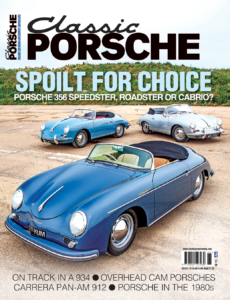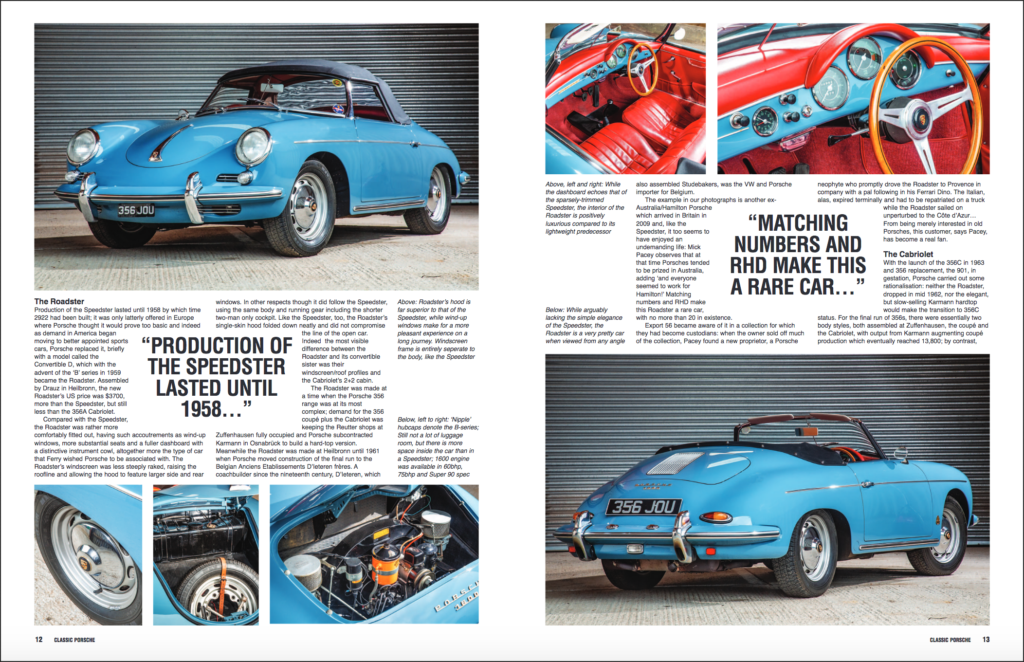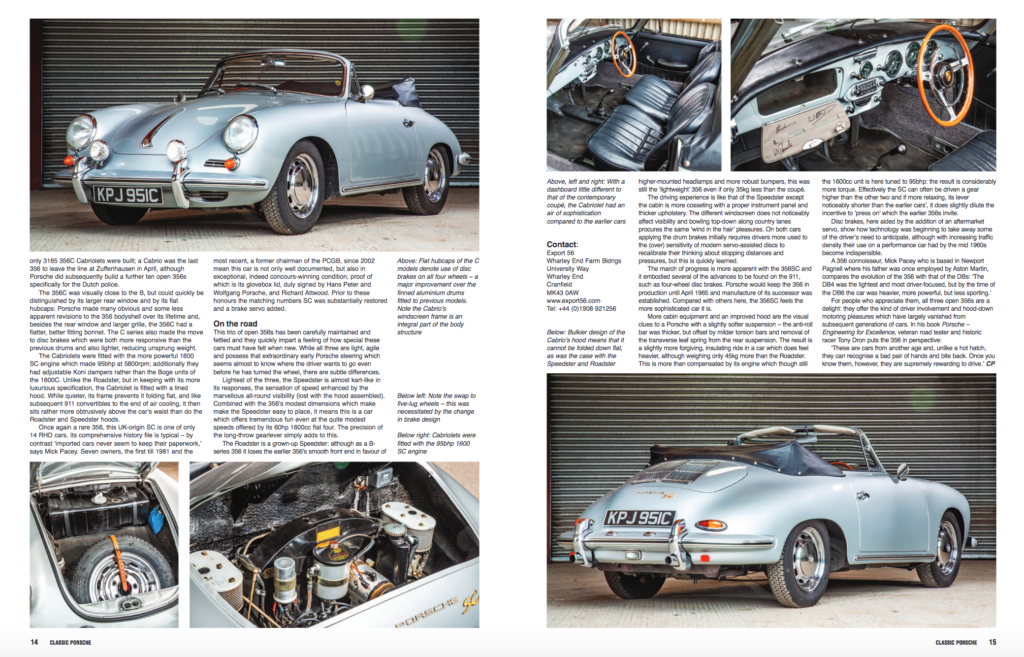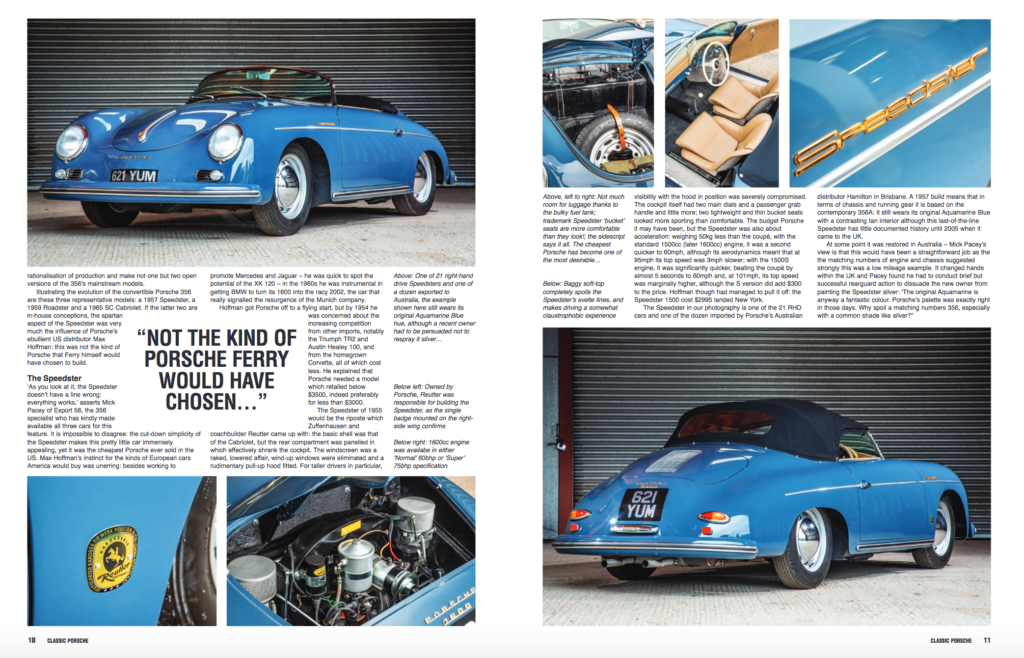Spoit for choice – Porsche 356 Speedster, Roadster or Cabrio?
If you count the early Gmünd cars, the 356 was made over sixteen years and, although Ferry’s first effort was the open barchetta which had its engine immediately behind the driver, the company soon moved to a closed coupé with the engine largely outside the wheelbase. Ferry felt his new sports model needed the increased interior space conferred by this configuration and a closed car would be more saleable in Europe than an open model exposing occupants to the rigours of Northern winters. There were also practical reasons: reversing the VW engine gearbox layout for the barchetta required off-set driveshafts and modifications to the suspension.
 Since the nascent Porsche manufacturer relied so much on Beetle underpinnings, it made sense not to deviate from them unnecessarily. So it was as a rear engined-coupé that the first production Porsche (later referred to as the ‘Pre-A’) appeared, although from the outset there was always interest in an open version: in 1949 the Swiss coachbuilder Beutler produced six convertibles from Gmünd chassis supplied by Bernard Blank, a Zürich hotelier and enthusiast of innovative cars who besides his patronage of Porsche was also the Tucker importer. Porsche itself would commission other coachbuilders.
Since the nascent Porsche manufacturer relied so much on Beetle underpinnings, it made sense not to deviate from them unnecessarily. So it was as a rear engined-coupé that the first production Porsche (later referred to as the ‘Pre-A’) appeared, although from the outset there was always interest in an open version: in 1949 the Swiss coachbuilder Beutler produced six convertibles from Gmünd chassis supplied by Bernard Blank, a Zürich hotelier and enthusiast of innovative cars who besides his patronage of Porsche was also the Tucker importer. Porsche itself would commission other coachbuilders.
Then after the initial flourish of 1948–9, Porsche production stagnated and Ferry acknowledged that the car business was merely breaking even. There were several factors behind this: for the latter part of 1949 and early 1950 the company was involved with moving from Gmünd and re-establishing itself in the Zuffenhausen suburb of Stuttgart; as the German economy started to revive with the inauguration in 1949 of the Federal Republic of Germany and a new currency, the deutschmark, so too did Volkswagen. Porsche’s commitment to VW signed in 1948 to supply engineering and undertake VW’s research and development was occupying a lot of engineering resources.
However, as a German now rather than Austrian entity, Porsche needed vehicle production to offset the significant profits from VW royalties and consultancy.
This committed move to manufacturing would soon show in Porsche’s results: for 1950, it built only 300 cars. But the figure for 1951 was 1031. Indeed by then so busy was Reutter trying to meet demand for the coupé, that open Porsches were subcontracted to other suppliers. Yet it would be demand from the US which by 1954 was accounting for a third of sales which would accelerate rationalisation of production and make not one but two open versions of the 356’s mainstream models.
Illustrating the evolution of the convertible Porsche 356 are these three representative models: a 1957 Speedster, a 1959 Roadster and a 1965 SC Cabriolet. If the latter two are in-house conceptions, the spartan aspect of the Speedster was very much the influence of Porsche’s ebullient US distributor Max Hoffman: this was not the kind of Porsche that Ferry himself would have chosen to build.
The Speedster
‘As you look at it, the Speedster doesn’t have a line wrong: everything works,’ asserts Mick Pacey of Export 56, the 356 specialist who has kindly made available all three cars for this feature. It is impossible to disagree: the cut-down simplicity of the Speedster makes this pretty little car immensely appealing, yet it was the cheapest Porsche ever sold in the US. Max Hoffman’s instinct for the kinds of European cars America would buy was unerring: besides working to promote Mercedes and Jaguar – he was quick to spot the potential of the XK 120 – in the 1960s he was instrumental in getting BMW to turn its 1600 into the racy 2002, the car that really signalled the resurgence of the Munich company.
Hoffman got Porsche off to a flying start, but by 1954 he was concerned about the increasing competition from other imports, notably the Triumph TR2 and Austin Healey 100, and from the homegrown Corvette, all of which cost less. He explained that Porsche needed a model which retailed below $3500, indeed preferably for less than $3000.
The Speedster of 1955 would be the riposte which Zuffenhausen and coachbuilder Reutter came up with: the basic shell was that of the Cabriolet, but the rear compartment was panelled in which effectively shrank the cockpit. The windscreen was a raked, lowered affair, wind-up windows were eliminated and a rudimentary pull-up hood fitted. For taller drivers in particular,
Above: One of 21 right-hand drive Speedsters and one of a dozen exported to Australia, the example shown here still wears its original Aquamarine Blue hue, although a recent owner had to be persuaded not to respray it silver…
The Speedster in our photography is one of the 21 RHD cars and one of the dozen imported by Porsche’s Australian distributor Hamilton in Brisbane. A 1957 build means that in terms of chassis and running gear it is based on the contemporary 356A: it still wears its original Aquamarine Blue with a contrasting tan interior although this last-of-the-line Speedster has little documented history until 2005 when it came to the UK.
At some point it was restored in Australia – Mick Pacey’s view is that this would have been a straightforward job as the the matching numbers of engine and chassis suggested strongly this was a low mileage example. It changed hands within the UK and Pacey found he had to conduct brief but successful rearguard action to dissuade the new owner from painting the Speedster silver: ‘The original Aquamarine is anyway a fantastic colour. Porsche’s palette was exactly right in those days. Why spoil a matching numbers 356, especially with a common shade like silver?”
The Roadster

Production of the Speedster lasted until 1958 by which time 2922 had been built; it was only latterly offered in Europe where Porsche thought it would prove too basic and indeed as demand in America began moving to better appointed sports cars, Porsche replaced it, briefly with a model called the Convertible D, which with the advent of the ‘B’ series in 1959 became the Roadster. Assembled by Drauz in Heilbronn, the new Roadster’s US price was $3700, more than the Speedster, but still less than the 356A Cabriolet.
Compared with the Speedster, the Roadster was rather more comfortably fitted out, having such accoutrements as wind-up windows, more substantial seats and a fuller dashboard with a distinctive instrument cowl, altogether more the type of car that Ferry wished Porsche to be associated with. The Roadster’s windscreen was less steeply raked, raising the roofline and allowing the hood to feature larger side and rear windows. In other respects though it did follow the Speedster, using the same body and running gear including the shorter two-man only cockpit. Like the Speedster, too, the Roadster’s single-skin hood folded down neatly and did not compromise the line of the open car. Indeed the most visible difference between the Roadster and its convertible sister was their windscreen/roof profiles and the Cabriolet’s 2+2 cabin.
The Roadster was made at a time when the Porsche 356 range was at its most complex; demand for the 356 coupé plus the Cabriolet was keeping the Reutter shops at Zuffenhausen fully occupied and Porsche subcontracted Karmann in Osnabrück to build a hard-top version. Meanwhile the Roadster was made at Heilbronn until 1961 when Porsche moved construction of the final run to the Belgian Anciens Etablissements D’Ieteren frères. A coachbuilder since the nineteenth century, D’Ieteren, which also assembled Studebakers, was the VW and Porsche importer for Belgium.
The example in our photographs is another ex-Australia/Hamilton Porsche which arrived in Britain in 2009 and, like the Speedster, it too seems to have enjoyed an undemanding life: Mick Pacey observes that at that time Porsches tended to be prized in Australia, adding ‘and everyone seemed to work for Hamilton!’ Matching numbers and RHD make this Roadster a rare car, with no more than 20 in existence.
Export 56 became aware of it in a collection for which they had become custodians: when the owner sold off much of the collection, Pacey found a new proprietor, a Porsche neophyte who promptly drove the Roadster to Provence in company with a pal following in his Ferrari Dino. The Italian, alas, expired terminally and had to be repatriated on a truck while the Roadster sailed on unperturbed to the Côte d’Azur… From being merely interested in old Porsches, this customer, says Pacey, has become a real fan.
The Cabriolet

With the launch of the 356C in 1963 and 356 replacement, the 901, in gestation, Porsche carried out some rationalisation: neither the Roadster, dropped in mid 1962, nor the elegant, but slow-selling Karmann hardtop would make the transition to 356C status. For the final run of 356s, there were essentially two body styles, both assembled at Zuffenhausen, the coupé and the Cabriolet, with output from Karmann augmenting coupé production which eventually reached 13,800; by contrast, only 3165 356C Cabriolets were built; a Cabrio was the last 356 to leave the line at Zuffenhausen in April, although Porsche did subsequently build a further ten open 356s specifically for the Dutch police.
The 356C was visually close to the B, but could quickly be distinguished by its larger rear window and by its flat hubcaps: Porsche made many obvious and some less apparent revisions to the 356 bodyshell over its lifetime and, besides the rear window and larger grille, the 356C had a flatter, better fitting bonnet. The C series also made the move to disc brakes which were both more responsive than the previous drums and also lighter, reducing unsprung weight.
The Cabriolets were fitted with the more powerful 1600 SC engine which made 95bhp at 5800rpm; additionally they had adjustable Koni dampers rather than the Boge units of the 1600C. Unlike the Roadster, but in keeping with its more luxurious specification, the Cabriolet is fitted with a lined hood. While quieter, its frame prevents it folding flat, and like subsequent 911 convertibles to the end of air cooling, it then sits rather more obtrusively above the car’s waist than do the Roadster and Speedster hoods.
Once again a rare 356, this UK-origin SC is one of only 14 RHD cars. Its comprehensive history file is typical – by contrast ‘imported cars never seem to keep their paperwork,’ says Mick Pacey. Seven owners, the first till 1981 and the most recent, a former chairman of the PCGB, since 2002 mean this car is not only well documented, but also in exceptional, indeed concours-winning condition, proof of which is its glovebox lid, duly signed by Hans Peter and Wolfgang Porsche, and Richard Attwood. Prior to these honours the matching numbers SC was substantially restored and a brake servo added.
On the road
This trio of open 356s has been carefully maintained and fettled and they quickly impart a feeling of how special these cars must have felt when new. While all three are light, agile and possess that extraordinary early Porsche steering which seems almost to know where the driver wants to go even before he has turned the wheel, there are subtle differences.
Lightest of the three, the Speedster is almost kart-like in its responses, the sensation of speed enhanced by the marvellous all-round visibility (lost with the hood assembled). Combined with the 356’s modest dimensions which make make the Speedster easy to place, it means this is a car which offers tremendous fun even at the quite modest speeds offered by its 60hp 1600cc flat four. The precision of the long-throw gearlever simply adds to this.
The Roadster is a grown-up Speedster: although as a B-series 356 it loses the earlier 356’s smooth front end in favour of higher-mounted headlamps and more robust bumpers, this was still the ‘lightweight’ 356 even if only 35kg less than the coupé.
The driving experience is like that of the Speedster except the cabin is more cosseting with a proper instrument panel and thicker upholstery. The different windscreen does not noticeably affect visibility and bowling top-down along country lanes procures the same ‘wind in the hair’ pleasures. On both cars applying the drum brakes initially requires drivers more used to the (over) sensitivity of modern servo-assisted discs to recalibrate their thinking about stopping distances and pressures, but this is quickly learned.
The march of progress is more apparent with the 356SC and it embodied several of the advances to be found on the 911, such as four-wheel disc brakes. Porsche would keep the 356 in production until April 1965 and manufacture of its successor was established. Compared with others here, the 356SC feels the more sophisticated car it is.
More cabin equipment and an improved hood are the visual clues to a Porsche with a slightly softer suspension – the anti-roll bar was thicker, but offset by milder torsion bars and removal of the transverse leaf spring from the rear suspension. The result is a slightly more forgiving, insulating ride in a car which does feel heavier, although weighing only 45kg more than the Roadster. This is more than compensated by its engine which though still the 1600cc unit is here tuned to 95bhp: the result is considerably more torque. Effectively the SC can often be driven a gear higher than the other two and if more relaxing, its lever noticeably shorter than the earlier cars’, it does slightly dilute the incentive to ‘press on’ which the earlier 356s invite.
Disc brakes, here aided by the addition of an aftermarket servo, show how technology was beginning to take away some of the driver’s need to anticipate, although with increasing traffic density their use on a performance car had by the mid 1960s become indispensible.
A 356 connoisseur, Mick Pacey who is based in Newport Pagnell where his father was once employed by Aston Martin, compares the evolution of the 356 with that of the DBs: ‘The DB4 was the lightest and most driver-focused, but by the time of the DB6 the car was heavier, more powerful, but less sporting.’
For people who appreciate them, all three open 356s are a delight: they offer the kind of driver involvement and hood-down motoring pleasures which have largely vanished from subsequent generations of cars. In his book Porsche – Engineering for Excellence, veteran road tester and historic racer Tony Dron puts the 356 in perspective:
‘These are cars from another age and, unlike a hot hatch, they can recognise a bad pair of hands and bite back. Once you know them, however, they are supremely rewarding to drive.’
First appeared in Classic Porsche Magazine No.65 – 22 AUG–25 SEPT 2019 (UK) – Words: Kieron Fennelly Photos: Andy Tipping
Download the front cover here.
Download the full article here.

